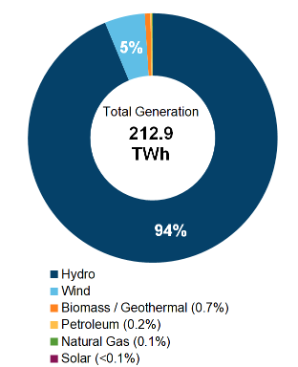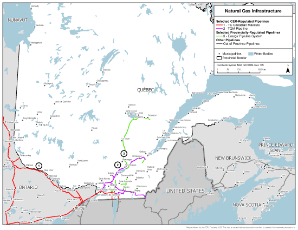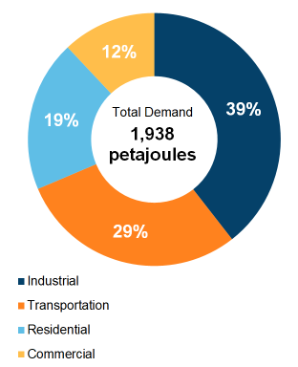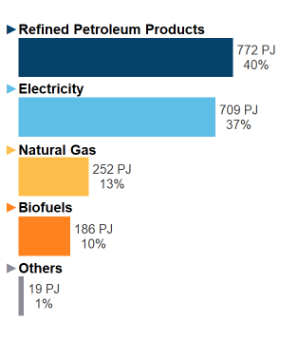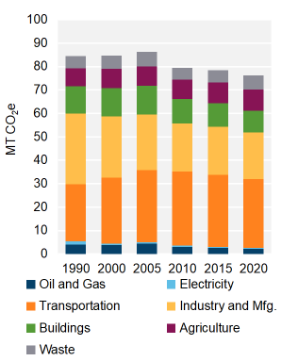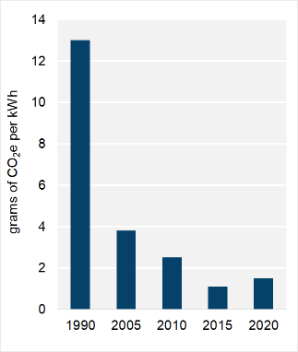Provincial and Territorial Energy Profiles – Quebec

On this page:
Connect/Contact Us
Please send comments, questions, or suggestions to
energy-energie@cer-rec.gc.ca
-
Figure 1: Electricity Generation by Fuel Type (2021)
Source and Description:
Source:
CER – Canada's Energy Future 2023 Data Appendix for Electricity GenerationDescription:
This pie chart shows electricity generation by source in Quebec. A total of 212.9 TWh of electricity was generated in 2021. -
Figure 2: Crude Oil Infrastructure Map
Source and Description:
Source:
CERDescription:
This map shows major CER-regulated crude oil pipelines, rail lines, and refineries in Quebec.Download:
PDF version [1,685 KB] -
Figure 3: Natural Gas Infrastructure Map
Source and Description:
Source:
CERDescription:
This map shows major CER-regulated natural gas pipelines in Quebec.Download:
PDF version [1,046 KB] -
Figure 4: End-Use Demand by Sector (2020)
Source and Description:
Source:
CER – Canada's Energy Future 2023 Data Appendix for End-Use DemandDescription:
This pie chart shows end-use energy demand in Quebec by sector. Total end-use energy demand was 1,728 PJ in 2020. The largest sector was industrial at 41% of total demand, followed by transportation (at 24%), residential (at 22%), and lastly, commercial (at 13%). -
Figure 5: End-Use Demand by Fuel (2020)
Source and Description:
Source:
CER – Canada's Energy Future 2023 Data Appendix for End-Use DemandDescription:
This figure shows end-use demand by fuel type in Quebec in 2020. Electricity accounted for 707 PJ (41%) of demand, followed by refined petroleum products at 599 PJ (35%), natural gas at 235 PJ (14%), biofuels at 171 PJ (10%), and other at 17 PJ (1%).
Note: "Other" includes coal, coke, and coke oven gas. -
Figure 6: GHG Emissions by Sector
Source and Description:
Source:
Environment and Climate Change Canada – National Inventory Report 1990-2022Description:
This stacked column graph shows GHG emissions in Quebec by sector from 1990 to 2022 in MT of CO2e. Total GHG emissions have decreased in Quebec from 84.4 MT of CO2e in 1990 to 79.1 MT of CO2e in 2022. -
Figure 7: Emissions Intensity from Electricity Generation
Source and Description:
Source:
Environment and Climate Change Canada – National Inventory Report 1990-2022Description:
This column graph shows the emissions intensity of electricity generation in Quebec from 1990 to 2022. In 1990, electricity generated in Quebec emitted 13 g of CO2e per kWh. By 2022, emissions intensity decreased to 1.2 g of CO2e per kWh.
Energy Production
Crude Oil
- Quebec does not have any commercial crude oil production.
Refined Petroleum Products (RPPs)
- Two large refineries currently operate in Quebec with a combined capacity of 402 thousand barrels per day (Mb/d):
- Montreal Refinery (Suncor)Footnote 1 in Montreal, with a capacity of 137 Mb/d and,
- Jean Gaulin Refinery (Valero)Footnote 2 in Lévis, near Quebec City, with a capacity of 265 Mb/d.
- Supply for Quebec’s refineries prior to 2013 was a mix of crude oil from eastern Canada and offshore imports from Africa, Europe, the Middle East, and Latin America. After 2013, use of crude oil from western Canada and the United States (U.S.) began increasing because of higher crude-by-rail deliveries, changes to pipeline infrastructure (Enbridge’s Line 9B reversal in 2015),Footnote 3 and higher production in the U.S.
Natural Gas/Natural Gas Liquids (NGLs)
- There is no natural gas production or field production of NGLs in Quebec.
- Small volumes of propane and butane are produced by oil refineries in Quebec.
- In 2018, the Quebec government placed a ban on hydraulic fracturing.
Renewable Natural Gas (RNG)
- The Government of Quebec developed a framework and environment to accelerate the production, distribution, and use of green hydrogen and bioenergy in 2022.Footnote 4 The goal is to increase bioenergy production by 50% by 2030 and adopt a target of 10% renewable natural gas (RNG) by 2030 in Quebec’s natural gas system.Footnote 5
- The City of Saint-Hyacinthe’s biomethanation project became operational in 2018 and has an annual production capacity of approximately 13 million cubic meters of RNG per year.Footnote 6
- A biomethanation plant, capable of producing 2.3 million cubic metres of RNG per year, was developed by the agricultural cooperative Coop Agri-Énergie Warwick.Footnote 7 Construction of the facility began in spring 2020, and the plant began operating in winter 2021.
- The Centre de traitement de la biomasse de la Montérégie (CTBM)Footnote 8 began operating in 2022 and produces 4.2 million cubic metres of biogas per year.Footnote 9 After consumption on site, 2.1 million cubic metres is available for injection into the Énergir network, the local gas distribution company.
- The Centre de biométhanisation de l’agglomération de Québec (CBAQ)Footnote 10 began operating in Quebec City in April 2023. It has the capacity to produce 10.2 million cubic metres of RNG per year.
- In May 2023, a new RNG production unit began operating at the Saint-Étienne-des-Grès landfill.Footnote 11 It was built by the Canadian subsidiary of Waga Energy. It produces 12.4 million cubic metres of RNG per year for injection into the Énergir network.
- In 2019, the City of Montréal signed a contract with SUEZ (which was acquired by French transnational Veolia Group in 2022) to build a biomethanation plant in Montreal East with a capacity of roughly 4 million cubic metres of RNG.Footnote 12
Electricity
- In 2021, Quebec generated 212.9 terawatt-hours (TWh) of electricity (Figure 1), which was about a third of total Canadian generation. Quebec is the top electricity producer in Canada and had an estimated generating capacity of 47,078 megawatts (MW) in 2021.
- With 41,487 MW of installed hydroelectric capacity, hydropower accounted for 94% of the electricity generated in Quebec in 2021. This includes Canada’s largest hydro plant, the 5,616 MW Robert-Bourassa facility in northern Quebec.Footnote 13 The facility underwent rehabilitation work that was completed in 2022.
- Quebec’s newest hydropower facility is the Romaine hydroelectric complex,Footnote 14 which is located on the Romaine River in the Côte-Nord region. It is comprised of four generating stations: Romaine-1 (270 MW), Romaine-2 (640 MW), and Romaine-3 (395 MW) and Romaine-4 (245 MW). The total installed capacity is 1,550 MW. Construction began in 2009 and finished with the completion of Romaine-4 in 2023.
- Wind is the second largest source of electricity generation in Quebec, contributing about 5% of total generation in 2021. Wind capacity is estimated at 4,363 MW and accounted for 9% of the province’s generating capacity in 2021. The two largest wind farms in Canada are located in Quebec: Seigneurie de BeaupréFootnote 15 (364 MW) and Rivière-du-MoulinFootnote 16 (350 MW).
- Five wind farms have entered service since 2018:
- Mont Sainte-MargueriteFootnote 17 (147 MW), 2018
- Nicolas-RiouFootnote 18 (224 MW), 2018
- Dune-du-NordFootnote 19 (6.4 MW), 2020
- Belles-Rivières (24 MW), 2021
- Des CulturesFootnote 20 (24 MW), 2022
- The 200 MW Apuiat wind farmFootnote 21 began construction in 2023 with commissioning of the project scheduled for December 2024. The wind farm, a partnership between Innu communities and Boralex, will be constructed in Port-Cartier in the Côte-Nord region.
- Quebec’s other sources of electricity generation include bioenergy, diesel (for power in remote communities), natural gas (mainly for peak winter demand), and solar.
- Hydro-Québec’s newest solar generating stations, Robert-A.-Boyd and Gabrielle-Bodis,Footnote 22 located in Varennes and La Prairie respectively, were commissioned in June 2021. The stations have a combined capacity of 9.5 MW.
- Hydro-Québec generates most of the electricity in the province, including electricity from 61 hydroelectric plants. Independent power producers operate several smaller hydroelectric plants, as well as all bioenergy and wind facilities.
Energy Transportation and Trade
Crude Oil and Liquids
- Quebec receives crude oil by Enbridge’s Line 9,Footnote 23 by tanker, and by rail (Figure 2). Quebec can also receive crude oil via the Portland-Montreal Pipeline,Footnote 24 but throughputs on the pipeline have been very low since 2016.
- Line 9 has been delivering crude oil from Sarnia, Ontario, to Montreal, Quebec, since its reversal became operational in December 2015. The line has a capacity of 300 Mb/d and transports crude oil from western Canada and the U.S. Midwest.
- Quebec also receives crude oil via tankers on the St. Lawrence River arriving at Montreal and Lévis.
- There are three rail terminals in Quebec capable of receiving crude oil, including one at each of the refineries in Montreal and Lévis, and one in Sorel-Tracy. These facilities have a combined capacity to receive approximately 123 Mb/d of crude oil.Footnote 25
- In 2023, deliveries of crude oil on the Portland-Montreal Pipeline averaged 6.2 Mb/d, or 3% of the pipeline’s capacity.
- Trans-Northern PipelineFootnote 26 delivered approximately 153 Mb/d of RPPs in 2023, including gasoline, diesel, aviation fuel, and heating fuel, from Montreal to markets in Ontario, and from the Nanticoke refinery in Ontario east to Toronto.
- Valero’s Saint-Laurent PipelineFootnote 27 has a capacity of 100 Mb/d and delivers RPPs from the Valero refinery in Lévis to a distribution terminal in east Montreal. It is regulated by the Régie du bâtiment du Québec.Footnote 28
Natural Gas
- The Trans Québec & MaritimesFootnote 29 (TQM) pipeline connects to TC Energy’s Canadian MainlineFootnote 30 near Saint Lazare, by the Ontario border. TQM transports natural gas to points within Quebec and exports natural gas to the U.S. At the international border in East Hereford, TQM connects to the Portland Natural Gas Transmission System.Footnote 31 (Figure 3)
- Quebec must source natural gas from outside the province to meet its needs. Historically, western Canada supplied much of Quebec’s natural gas. Now, Quebec can also receive gas produced in the U.S. because of increased import capacity in Ontario.
- ÉnergirFootnote 32 (formerly Gaz Métro) distributes gas to more than 300 municipalities on almost 10,000 kilometres (km) of pipelines.Footnote 33 Enbridge GazifèreFootnote 34 serves more than 43,500 customers in the Outaouais region and owns and operates 1,000 km of pipelines.Footnote 35 Énergir and Gazifère are provincially regulated by Quebec’s Régie de l’énergie.Footnote 36
- IntragazFootnote 37 is an underground natural gas storage operator that operates the only two underground natural gas storage sites in Quebec – the Pointe-du-Lac site, which has a capacity of 1.3 billion cubic feet (Bcf) and the Saint-Flavien site, which has a capacity of 4.2 Bcf. Both sites are connected to the TQM pipeline.
Liquefied Natural Gas (LNG)
- Énergir has operated a liquefaction, storage, and regasification plant in Montreal East since 1971. Énergir tripled the plant’s capacity in 2017 to over nine Bcf of LNG to help meet growing demand for LNG by the road and marine transportation sectors, as well as for regions not connected to the natural gas grid.Footnote 38
- In 2016, the National Energy Board approved a 25-year export licence [Filing A72342] for GNL Quebec for its proposed Énergie Saguenay LNG export facility. The project was scheduled to be operational in 2026 but was rejected by the province of Quebec in 2021 because of financial and environmental concerns. The Impact Assessment Agency of Canada (IAAC) also denied the project in 2022 citing adverse environmental effects.Footnote 39
Electricity
- In 2023, Quebec’s net electricity interprovincial and international inflows were 14.2 TWh. Typically, Quebec is Canada’s largest electricity exporter. However, in 2023, exports decreased due to low water levels in hydroelectric reservoirs.Footnote 40
- Under long-term contracts signed in 1969, Hydro-Québec can access approximately 85% of the 5,428 MW of electricity produced at the Churchill Falls hydroelectric stationFootnote 41 in Labrador until 2041. It is the second largest underground hydroelectric plant in North America. Negotiations are currently underway to increase production by 1,600 MW.Footnote 42
- Quebec also trades with electricity markets in the U.S. Northeast, primarily New England and New York. In 2022, Quebec exported more electricity to the U.S. than any other province, with gross exports of 22.6 TWh.Footnote 43
- Hydro-Québec operates 34,922 km of transmission lines and 228,568 km of distribution lines.Footnote 44 Fifteen interconnections link Quebec’s electricity system with systems in Ontario, the Maritime provinces, and the U.S. Northeast.
- Construction work for the Appalaches-Maine Interconnection ProjectFootnote 45 began in summer 2023. The project will increase the electricity exchange capacity between Quebec and New England through 100 km of new 320-kilovolt direct-current electricity lines. The project received government and Canada Energy Regulator (CER) approvalsFootnote 46 in 2021 and commissioning of the line is scheduled for 2025.
- Construction work for the Hertel-New York Interconnection ProjectFootnote 47 began in January 2024. The project aims to supply 1,250 MW of electricity from Quebec to New York City. In Quebec, the project involves the construction of a 57.7 km line and will connect to the Champlain Hudson Power Express project in the U.S. The project received CER approval in July 2023.Footnote 48
Energy Consumption and Greenhouse Gas (GHG) Emissions
Total Energy Consumption
- In 2020, end-use demand in Quebec was 1,728 petajoules (PJ). Industrial demand was the largest sector for energy demand at 41%, followed by transportation at 24%, residential at 22%, and commercial at 13% (Figure 4). Quebec’s total energy demand was the third largest in Canada, and the eighth largest per capita of the provinces.
- Electricity was the main energy consumed in Quebec, accounting for 707 PJ, or 41% of total end-use demand. RPPs and natural gas accounted for 599 PJ (35%) and 235 PJ (14%), respectively (Figure 5).
Refined Petroleum Products
- Quebec’s motor gasoline demand in 2022 was 988 litres per capita, 4% below the national average of 1,035 litres per capita.
- Quebec’s diesel demand in 2022 was 554 litres per capita, 28% below the national average of 772 litres per capita.
- Most of the gasoline consumed in Quebec is refined in the province. However, some gasoline is imported from the U.S. East Coast and Europe or is transferred from the Maritimes.
Natural Gas
- In 2023, Quebec consumed an average of 590 million cubic feet per day (MMcf/d) of natural gas. This was 5% of total Canadian demand.
- Quebec’s industrial sector was the largest consuming sector for natural gas at 385 MMcf/d in 2023. The commercial and residential sectors consumed 150 MMcf/d and 56 MMcf/d, respectively.
Electricity
- In 2020, annual electricity consumption per capita in Quebec was 22.9 megawatt-hours (MWh). Quebec had Canada’s highest per capita electricity consumption and consumed 57% more than the national average. This is largely due to the presence of some industries, such as aluminum smelters that rely on large amounts of low-cost electricity, as well as most residents in Quebec who use electricity for space heating.
- Quebec’s largest consuming sector for electricity in 2020 was industrial at 87 TWh. The residential and commercial sectors consumed 71 TWh and 38 TWh, respectively.
GHG Emissions
- Quebec’s GHG emissions in 2022 were 79.1 megatonnes of carbon dioxide equivalent (MT CO2e).Footnote 49 Quebec’s emissions have declined 6% since 1990 and 8% since 2005.
- In 2022, Quebec’s emissions per capita were the lowest in Canada at 9.1 tonnes CO2e. This is 50% below the Canadian average of 18.2 tonnes per capita.
- The largest emitting sectors in Quebec are transportation at 39% of emissions, industries and manufacturing at 28%, and buildings (residential and commercial) at 12% (Figure 6).
- Quebec’s GHG emissions from the oil and gas sector in 2022 were 2.3 MT CO2e. Of this total, 0.1 MT were attributable to transmission and 2.2 MT were attributable to petroleum refining and natural gas distribution.
- Virtually all electricity produced in Quebec comes from renewable sources. In 2022, Quebec’s power sector generated 0.3 MT CO2e emissions, which represents 0.6% of Canada’s GHG emissions from power generation.
- The greenhouse gas intensity of Quebec’s electricity grid, measured as the GHGs emitted in the generation of the province’s electric power, was 1.2 grams of CO2e per kilowatt-hour (g CO2e/kWh) in 2022. This is a 68% reduction from the province’s 2005 level of 3.8 g CO2e/kWh. The national average in 2022 was 100 g CO2e/kWh (Figure 7).
Energy Authorities
- Date modified:

